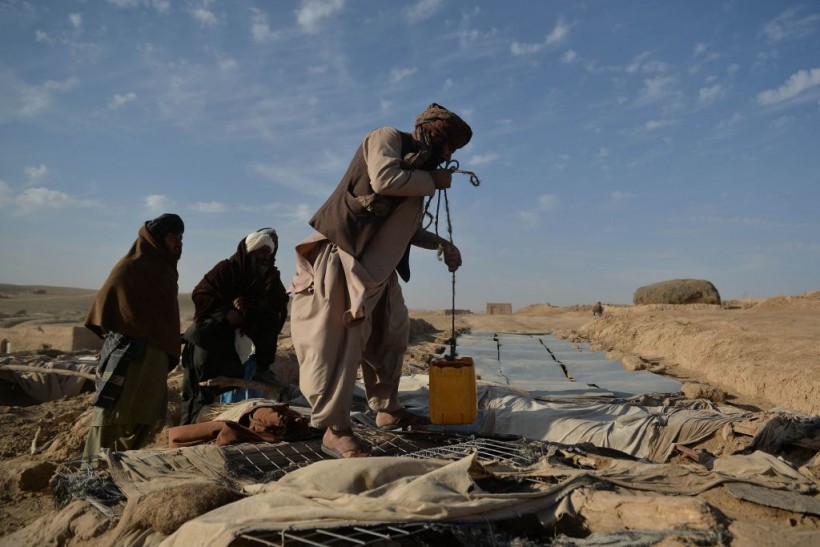
(Photo : HOSHANG HASHIMI/AFP via Getty Images)
This picture taken on October 15, 2021, shows a man collecting water from a water storage at Haji Rashid village of Bala Murghab district in Badghis province. - Drought stalks the parched fields around the remote Afghan district of Bala Murghab, where climate change is proving a deadlier foe than the country's recent conflicts.
Two subsequent earthquakes in Afghanistan took the lives of more than two dozen people in the nation's western regions. The U.S. Geological Survey reported a 5.3 magnitude earthquake followed by a 4.9 magnitude one that occurred two hours later.
The fatalities from the incident included five women and four children, while four other people were injured because of the tremors. The announcement was made by a spokesman for the province of Badghis, Baz Mohammad Sarwary.
Deadly Earthquakes
The official reportedly added more people to the victim list whose lives were lost after the roofs of their houses crushed them collapsed on top of them. The victims were reported to have come from the Qadis district. Sarwary also warned people that the number of fatalities could go up as the area was a mountainous region and one of the nation's poorest and most underdeveloped areas.
The leader of the Emergency Operations Center of the Ministry of State for Emergency Affairs, Mullah Janan Saeqe, confirmed the death toll of at least 26 people. He added that more than 700 homes were damaged by the shaking, The Hill reported.
Read Also: Joe Biden's Allies Foresee Probes, Impeachment Attempts as Midterm Election Looms
Sarwary said that the first rescuers had already arrived at some of the affected areas under heavy rain. The subsequent earthquakes also damaged houses and affected residents of the Muqr district in the province. However, officials have not provided details of the incident, including casualties.
The official noted that the two tremors were felt across the province and that some homes in Qala-e-Naw, the provincial capital, suffered cracks. Fortunately, Sarwary said there were no major injuries or widespread damage in the area. The European-Mediterranean Seismological Centre released a report that showed the quake's depth was at a depth of 30 kilometers, Al Jazeera reported.
Rescuing Survivors
In a phone call with one resident from an affected district, Azmatullah Sharifi said that the death toll would be rising dramatically. He argued that many more families were still buried under the rubble, waiting to be rescued or to meet their end.
Residents took photographs of the aftermath of the two earthquakes and, provided by Sarwary, showed men and boys digging out rocks and debris using their bare hands. Residents worked to remove clay bricks and other rubble to reach any survivor that could still be trapped under the fallen buildings.
The situation came as civilians in the nation were struggling amid a humanitarian crisis brought by a war that had gone on for years. Many earthquakes have struck along Afghanistan's eastern borders with Pakistan and Tajikistan in recent weeks, as shown by data from the U.S. Geological Survey.
A similar incident in 2015 occurred when an earthquake took the lives of more than 300 people in the region's northern areas and from Pakistan. Another tremor, which occurred 24 years earlier, took the lives of a similar number of people, despite the majority of quakes in the region being magnitude 5 or less, the New York Times reported.
Related Article: Trump Supporters Believe Deceased JFK Jr. Is 'Coming Back' To Be Former President's VP








